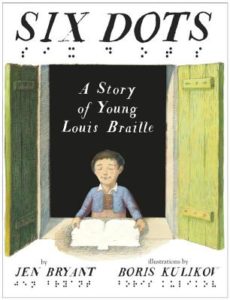Real people doing real things. Picture Book biographies provide readers with engaging opportunities to learn about the small and large steps ordinary people have taken to accomplish extraordinary things. Beginning as early as second grade, students are expected to “describe the connection between a series of historical events… in a text.” (CCSS.ELA-LITERACY.RI.2.3) What better way to introduce readers to informational books than with one of the many beautiful biographies being published today. Here are two that work especially well.
“Inside an enormous city in a house on a very small street, there once lived a poet I would like you to meet.” enormous smallness: A story E.E. Cummings (Enchanted Lion Books, 2015) by Matthew Burgess, illustrations by Kris Di Giacomo is the gorgeously written and illustrated story of Edward Estlin Cummings. From the first page, readers are immersed in e.e.’s world – from the lively house on 104 Irving Street (where e.e. recited his first poem, at the age of three: “Oh, my little/ birdie, Oh/with his little/toe, toe, toe!”), to the home at 4 Patching Place where he lived for almost forty years.
With snippets of some of e.e. cummings’s poems seamlessly woven into the visual narrative which is represented on thick pages, rich in a palette of muted colors – blues, grays, browns, and greens – the book is a magnificently produced collage of the words, heart, and voice of e.e.

Jen Bryant has written numerous celebrated picture book biographies. Six Dots: A Story of Young Louis Braille (Alfred A. Knopf, 2016) with illustrations by Boris Kulikov is her newest. In fact, what makes this book especially fascinating is that it is Bryant’s second book about Louis Braille. (The first was a young adult biography published as part of a series.) Why was Bryant compelled to write a second book for younger readers? She says it was because she’d never read (or written) an account about Braille that let her experience this child inventor’s emotions. “What was it like to BE Louis Braille? This story is my attempt to answer that question.”
Imagine, then, being the young Louis Braille, a clever boy who loses his sight at the age of five. Even though he’s given a chance to attend a very special school in Paris, the Royal School for the Blind didn’t feel so special to Louis. The other boys teased him and he missed his maman. Still, he persisted because somewhere in that school was a library with books. He longed to read, but these books were large and cumbersome, with waxy letters and words as large as his hand.
Louis was determined to find a better way and, at the young age of fifteen, inspired by a secret code invented by a French army captain, he devised an easier code that used just six dots. Many kids will know about Braille, but I’m guessing most will not know Louis’s amazing story of determination and grit.










